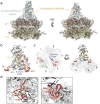Structure of the Cdc48 ATPase with its ubiquitin-binding cofactor Ufd1-Npl4
- PMID: 29967539
- PMCID: PMC6044470
- DOI: 10.1038/s41594-018-0085-x
Structure of the Cdc48 ATPase with its ubiquitin-binding cofactor Ufd1-Npl4
Abstract
Many polyubiquitinated proteins are extracted from membranes or complexes by the conserved ATPase Cdc48 (in yeast; p97 or VCP in mammals) before proteasomal degradation. Each Cdc48 hexamer contains two stacked ATPase rings (D1 and D2) and six N-terminal (N) domains. Cdc48 binds various cofactors, including the Ufd1-Npl4 heterodimer. Here, we report structures of the Cdc48-Ufd1-Npl4 complex from Chaetomium thermophilum. Npl4 interacts through its UBX-like domain with a Cdc48 N domain, and it uses two Zn2+-finger domains to anchor the enzymatically inactive Mpr1-Pad1 N-terminal (MPN) domain, homologous to domains found in several isopeptidases, to the top of the D1 ATPase ring. The MPN domain of Npl4 is located above Cdc48's central pore, a position similar to the MPN domain from deubiquitinase Rpn11 in the proteasome. Our results indicate that Npl4 is unique among Cdc48 cofactors and suggest a mechanism for binding and translocation of polyubiquitinated substrates into the ATPase.
Conflict of interest statement
The authors declare no competing financial interests.
Figures





Similar articles
-
Structural insights into ubiquitin recognition and Ufd1 interaction of Npl4.Nat Commun. 2019 Dec 13;10(1):5708. doi: 10.1038/s41467-019-13697-y. Nat Commun. 2019. PMID: 31836717 Free PMC article.
-
Substrate processing by the Cdc48 ATPase complex is initiated by ubiquitin unfolding.Science. 2019 Aug 2;365(6452):eaax1033. doi: 10.1126/science.aax1033. Epub 2019 Jun 27. Science. 2019. PMID: 31249135 Free PMC article.
-
Translocation of polyubiquitinated protein substrates by the hexameric Cdc48 ATPase.Mol Cell. 2022 Feb 3;82(3):570-584.e8. doi: 10.1016/j.molcel.2021.11.033. Epub 2021 Dec 23. Mol Cell. 2022. PMID: 34951965 Free PMC article.
-
Toward an understanding of the Cdc48/p97 ATPase.F1000Res. 2017 Aug 3;6:1318. doi: 10.12688/f1000research.11683.1. eCollection 2017. F1000Res. 2017. PMID: 28815021 Free PMC article. Review.
-
Cdc48-Ufd1-Npl4: stuck in the middle with Ub.Curr Biol. 2002 May 14;12(10):R366-71. doi: 10.1016/s0960-9822(02)00862-x. Curr Biol. 2002. PMID: 12015140 Review.
Cited by
-
Structural insights into ubiquitin recognition and Ufd1 interaction of Npl4.Nat Commun. 2019 Dec 13;10(1):5708. doi: 10.1038/s41467-019-13697-y. Nat Commun. 2019. PMID: 31836717 Free PMC article.
-
Functional Inhibition of Valosin-Containing Protein Induces Cardiac Dilation and Dysfunction in a New Dominant-Negative Transgenic Mouse Model.Cells. 2021 Oct 26;10(11):2891. doi: 10.3390/cells10112891. Cells. 2021. PMID: 34831118 Free PMC article.
-
A Retrotranslocation Assay That Predicts Defective VCP/p97-Mediated Trafficking of a Retroviral Signal Peptide.mBio. 2022 Feb 22;13(1):e0295321. doi: 10.1128/mBio.02953-21. Epub 2022 Jan 4. mBio. 2022. PMID: 35089078 Free PMC article.
-
Structural insights of the p97/VCP AAA+ ATPase: How adapter interactions coordinate diverse cellular functionality.J Biol Chem. 2023 Nov;299(11):105182. doi: 10.1016/j.jbc.2023.105182. Epub 2023 Aug 22. J Biol Chem. 2023. PMID: 37611827 Free PMC article. Review.
-
A protein quality control pathway at the mitochondrial outer membrane.Elife. 2020 Mar 2;9:e51065. doi: 10.7554/eLife.51065. Elife. 2020. PMID: 32118579 Free PMC article.
References
-
- Zhang X, et al. Structure of the AAA ATPase p97. Mol Cell. 2000;6:1473–1484. - PubMed
Publication types
MeSH terms
Substances
Grants and funding
LinkOut - more resources
Full Text Sources
Other Literature Sources
Molecular Biology Databases
Miscellaneous

